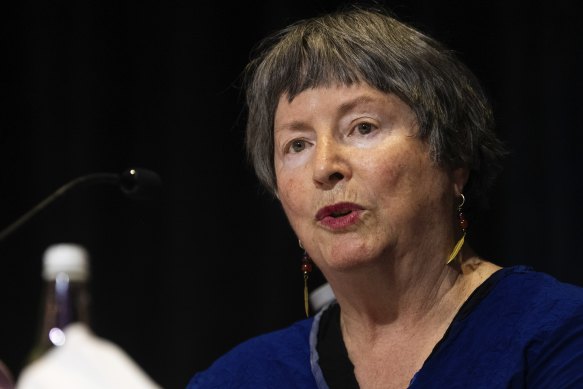This was published 1 year ago
The disability commission was split on special schools. Those with lived experience want them closed
Disability Royal Commissioner Dr Rhonda Galbally said governments should give significant weight to her own and two colleagues’ lived experience with disabilities when deciding whether to back their call for all special schools to be shut within 30 years, after the commission split over the future of segregated education.
The division among the six commissioners about the future of special schools was a key feature of the landmark 12-volume final report of the Disability Royal Commission, with a three-three split among the experts leaving governments without a clear authority on the issue and facing a choice about the best way forward.

Commissioner Dr Rhonda Galbally says she hopes governments will place significant weight on her views and those of two other commissioners with lived experience with disabilities when deciding whether to end segregated schooling. Credit: Rhett Wyman
In an interview following the public release of the report on Friday, Galbally acknowledged that the lack of consensus on segregated education had diluted the commission’s influence on the matter, as she stressed that the three commissioners urging the closure of special schools had direct experience with disabilities.
“But on the other hand, the two commissioners with disability are recommending this and the other commissioner who is recommending it is a parent of a grown woman with a disability,” Galbally, a former board member of the National Disability Insurance Agency, said.
“I think governments will give really significant weight to lived experience, to the expertise of people with disabilities. I think that will really be very weighty for them.”
Over the course of the 4½-year commission – which cost $600 million and received evidence from more than 9000 people with disabilities, their families, carers and advocates – no dedicated public hearings were held on special schools.
Hinting at friction among the commissioners on this issue, Galbally said this aspect was “very disappointing”, adding: “some of us raised it many times and would have wished it was different.”
Galbally and commissioner Alastair McEwin, who both live with a disability, joined with commissioner Barbara Bennett in recommending that no new special schools be built from 2025 and that all existing schools be closed by 2051. Bennett’s daughter was diagnosed with multiple sclerosis at 12 years old.
In a joint position, they concluded that “segregated education stems from, and contributes to, the devaluing of people with disability” and the continued maintenance of segregation in education settings was “incompatible” with the United Nations Convention on the Rights of Persons with Disabilities.
But their position diverged with that advocated by the commission’s chair, Ronald Sackville, and commissioners John Ryan and Andrea Mason, who found that separate settings did not need to – and should not – involve people with a disability being isolated from their peers or the general community. They recommended a range of measures aimed at ensuring there was regular interaction between students at special schools and those at mainstream schools.
But Galbally said this approach risked being tokenistic and would not drive the attitude change needed for people with disabilities to be seen as equal to able-bodied people.
“Students having contact that’s not gritty and day-to-day and in the process of doing what one does at school, which is learning and playing, it can become a little token,” Galbally said.
She said it was clear that the dual system of education was “failing” children with disabilities, pointing to modelling done by the commission.
“If you go to a special school, you’re 85 per cent more likely to end up in a sheltered workshop and with very limited living options as an adult,” Galbally said.
The three commissioners’ proposal to phase out special schools was welcomed by peak body Children and Young People with Disability Australia, and Down Syndrome Australia, but they also expressed disappointment at the long timeline to 2051.
Galbally said that she understood the dismay from those groups, but said it was driven by a need to ensure there was as much consensus as possible and encourage governments to embrace it.
“If governments feel they could do this sooner, that would be really great. We were aware that out of all the settings we’ve addressed … this schooling one is the one governments would probably find most difficult and so it was an attempt to really try and allow them time to get this done,” she said.
However, some experts have questioned the feasibility of closing all non-mainstream schools and removing choice for parents, while others say the lack of unanimity from the royal commission could erode the political will and substantial funding commitments required to overhaul the education sector to remove segregation.
Former NDIS board member Martin Lavery, chief executive of one of Australia’s largest charitable providers, said he was “really concerned that the royal commission has outlined a destination that we as a society haven’t yet grappled with how to pay for”.
“If we see the end of special schools too, the end of group homes too suddenly, and supported employment being turned off too suddenly, our society hasn’t yet got the mechanism to meet those costs,” he said.
Laverty said the taskforce established by the federal government in response to the commission’s findings needed to hear the message that segregation must end, and determine the “pace at which the taxpayer, the families, the charitable organisations, but most importantly, the people with disabilities want that transition to occur.”
Start the day with a summary of the day’s most important and interesting stories, analysis and insights. Sign up for our Morning Edition newsletter.